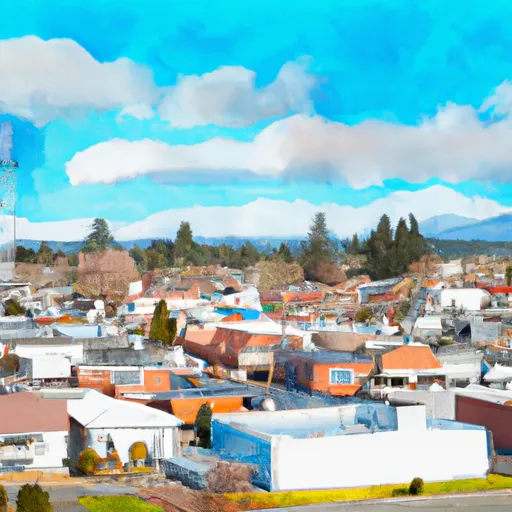-
 Snoflo Premium
Snoflo Premium
Get unlimited access to all our content
With no Ad interruptions! - Start Your Free Trial Login with existing account
Stratford
Eden Index
Climate
8.5
•
Recreation
5.5
•
Community
•
Safeguard
5.3/10

Stratford, Washington is a small town located in Grant County, in the central part of the state. The climate in Stratford is considered semi-arid, with hot and dry summers and cool winters. The average temperature in the summer ranges from the mid-80s to low 90s °F (high 20s to low 30s °C), while winter temperatures typically range from the mid-30s to low 40s °F (1 to 5 °C). Precipitation is relatively low, with most of it occurring during the winter months.
Hydrologically, Stratford benefits from the nearby Crab Creek, which flows through the area. The creek is a vital water source for both irrigation and wildlife. It provides opportunities for fishing, bird-watching, and enjoying the natural beauty of the surrounding landscape.
Outdoor recreation is abundant in Stratford and its surrounding areas. The region offers opportunities for hiking, camping, and wildlife viewing. Additionally, the nearby Moses Lake provides opportunities for boating, water skiing, and swimming during the hot summer months. The area is also known for its opportunities for hunting and bird-watching, with a variety of species to observe. Overall, Stratford's climate, hydrology constituents, and outdoor recreation opportunities make it an attractive destination for those seeking to enjoy the natural beauty of central Washington.
What is the Eden Index?
The Snoflo Eden Index serves as a comprehensive rating system for regions, evaluating their desirability through a holistic assessment of climate health, outdoor recreation opportunities, and natural disaster risk, acknowledging the profound impact of these factors on livability and well-being.
Climate Health Indicator (CHI): 8.5
Stratford receives approximately
231mm of rain per year,
with humidity levels near 64%
and air temperatures averaging around
10°C.
Stratford has a plant hardyness factor of
6, meaning
plants and agriculture in this region thrive during a short period during spring and early summer. Most
plants will die off during the colder winter months.
By considering the ideal temperature range, reliable water supplies, clean air, and stable seasonal rain or snowpacks, the Climate Health Indicator (CHI) underscores the significance of a healthy climate as the foundation for quality living.
A healthy climate is paramount for ensuring a high quality of life and livability in a region, fostering both physical well-being and environmental harmony. This can be characterized by ideal temperatures, reliable access to water supplies, clean air, and consistent seasonal rain or snowpacks.
Weather Forecast
Streamflow Conditions
Upper Columbia
Area Rivers
Upper Columbia
Snowpack Depths
Upper Columbia
Reservoir Storage Capacity
Upper Columbia
Groundwater Levels
Recreational Opportunity Index (ROI): 5.5
The Recreational Opportunity Index (ROI) recognizes the value of outdoor recreational options, such as parks, hiking trails, camping sites, and fishing spots, while acknowledging that climate plays a pivotal role in ensuring the comfort and consistency of these experiences.
Access to outdoor recreational opportunities, encompassing activities such as parks, hiking, camping, and fishing, is crucial for overall well-being, and the climate plays a pivotal role in enabling and enhancing these experiences, ensuring that individuals can engage in nature-based activities comfortably and consistently.
Camping Areas
| Campground | Campsites | Reservations | Toilets | Showers | Elevation |
|---|---|---|---|---|---|
| Glen Williams - WDFW | None | 1,050 ft | |||
| Million Dollar North - WDFW | None | 1,604 ft | |||
| Warden Lake North - WDFW | None | 1,072 ft | |||
| Coulee City Community Park | None | 1,574 ft | |||
| Lind Coulee Island Site WDFW | None | 1,054 ft | |||
| Lind Coulee West Bridge Site WDFW | None | 1,053 ft | |||
| Potholes State Park | 121 | 1,050 ft | |||
| Blue Lake - WDFW | None | 1,110 ft | |||
| Ankeny No. 1 - WDFW | None | 1,568 ft | |||
| Alkali Lake - WDFW | None | 1,097 ft |
Nearby Ski Areas
Catastrophe Safeguard Index (CSI):
The Catastrophe Safeguard Index (CSI) recognizes that natural disaster risk, encompassing floods, fires, hurricanes, and tornadoes, can drastically affect safety and the overall appeal of an area.
The level of natural disaster risk in a region significantly affects safety and the overall livability, with climate change amplifying these risks by potentially increasing the frequency and intensity of events like floods, fires, hurricanes, and tornadoes, thereby posing substantial challenges to community resilience and well-being.
Community Resilience Indicator (CRI):
The Community Resilience Indicator (CRI) recognizes that education, healthcare, and socioeconomics are crucial to the well-being of a region. The CRI acknowledges the profound impact of these elements on residents' overall quality of life. By evaluating educational resources, healthcare accessibility, and economic inclusivity, the index captures the essential aspects that contribute to a thriving community, fostering resident satisfaction, equity, and social cohesion.

